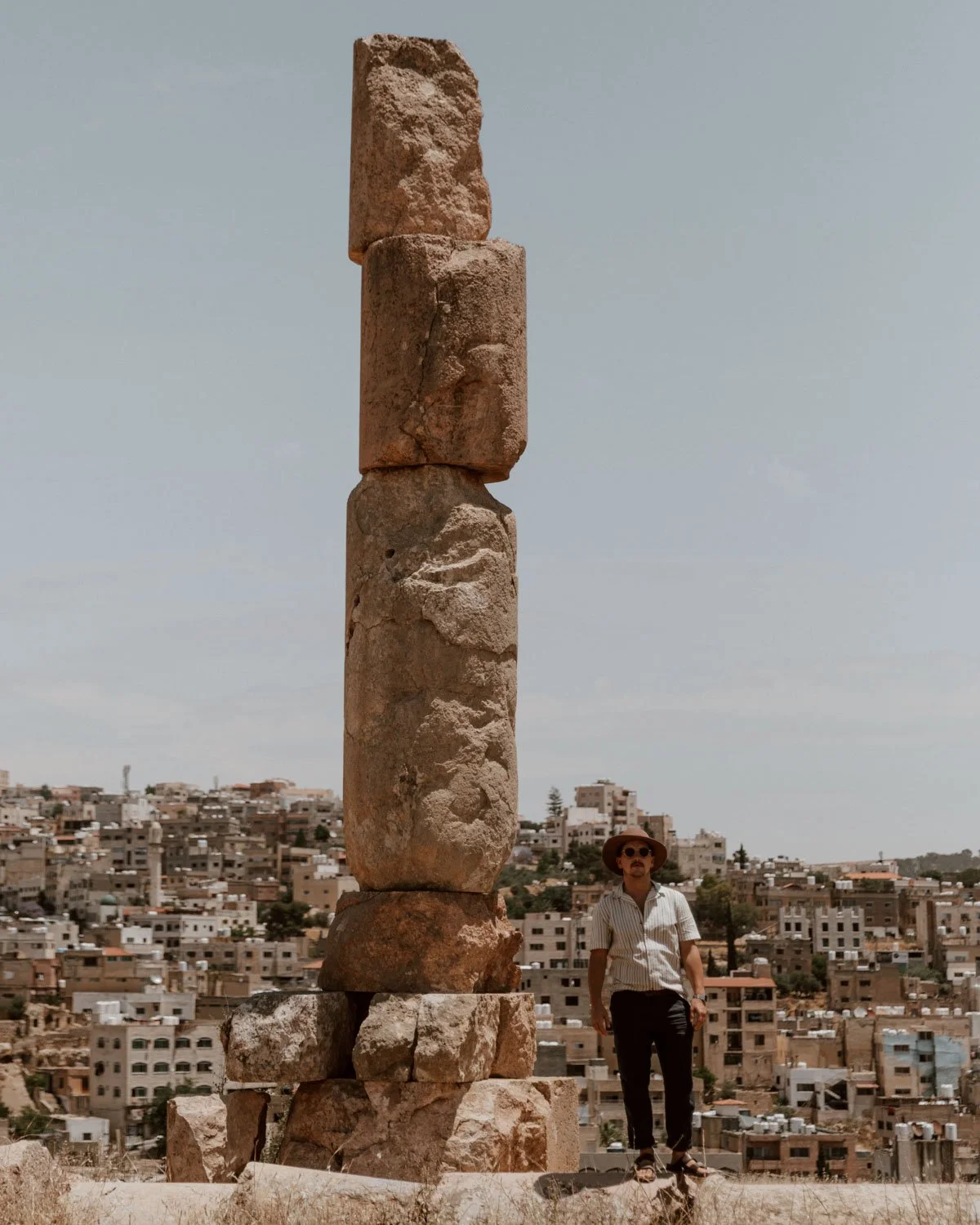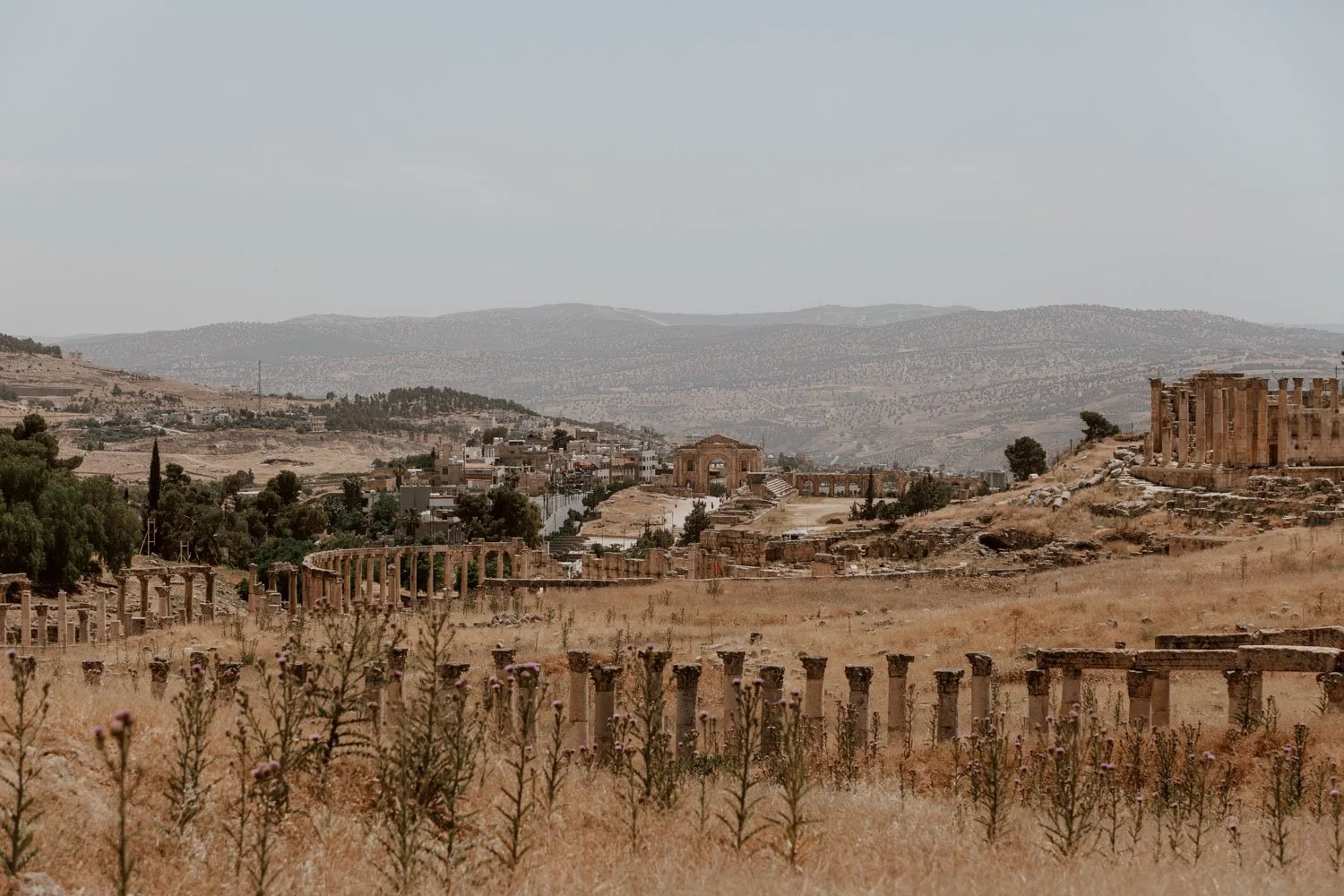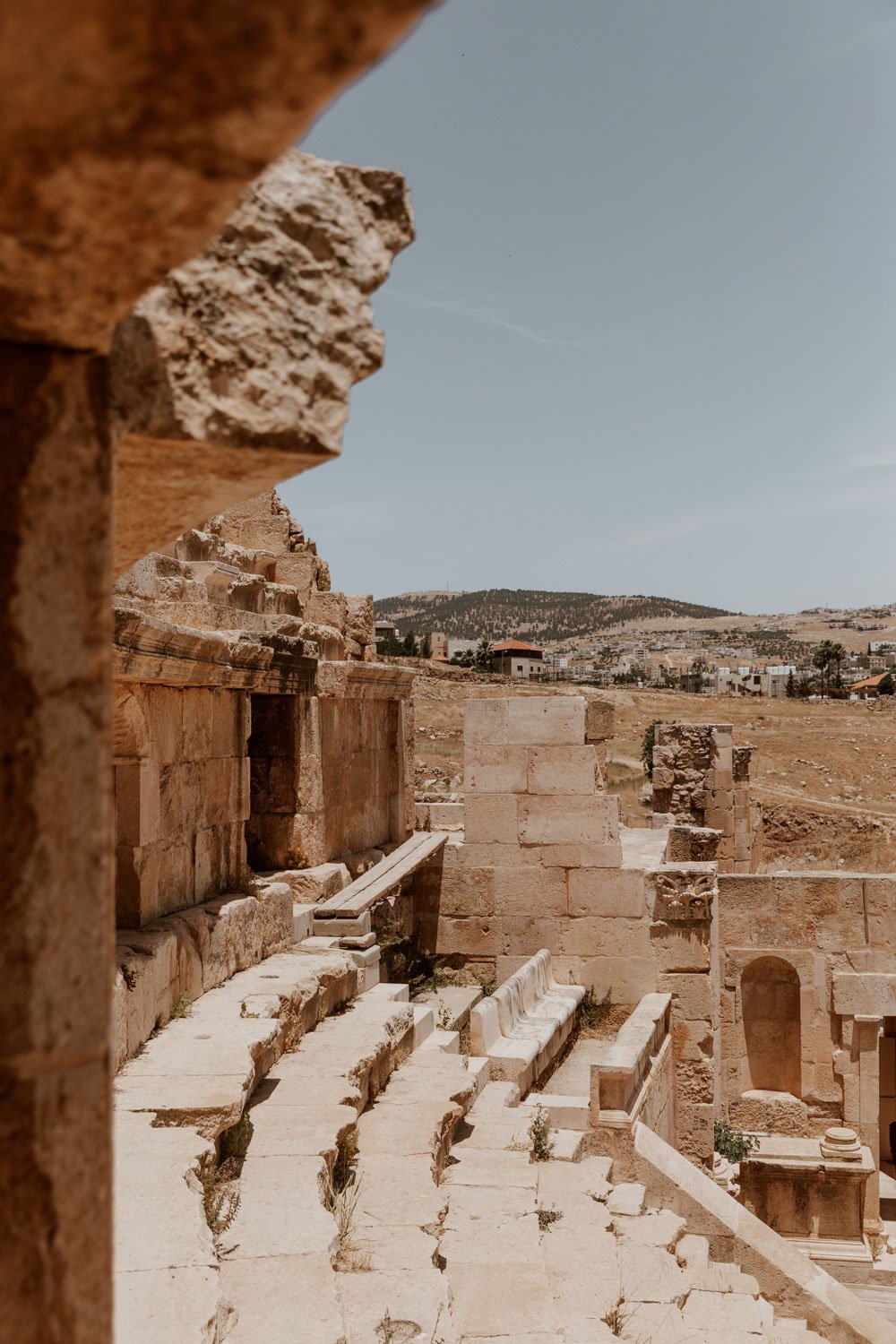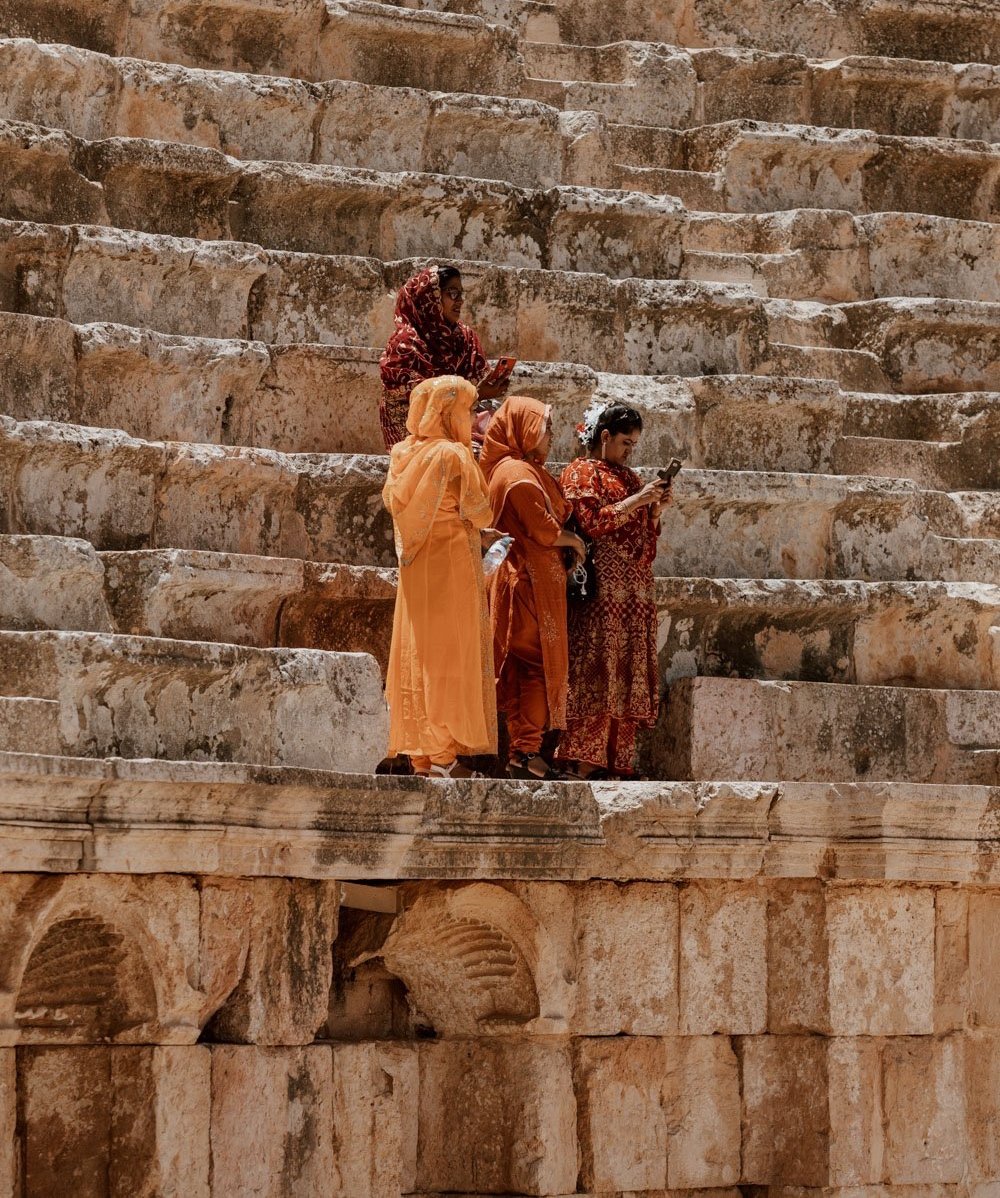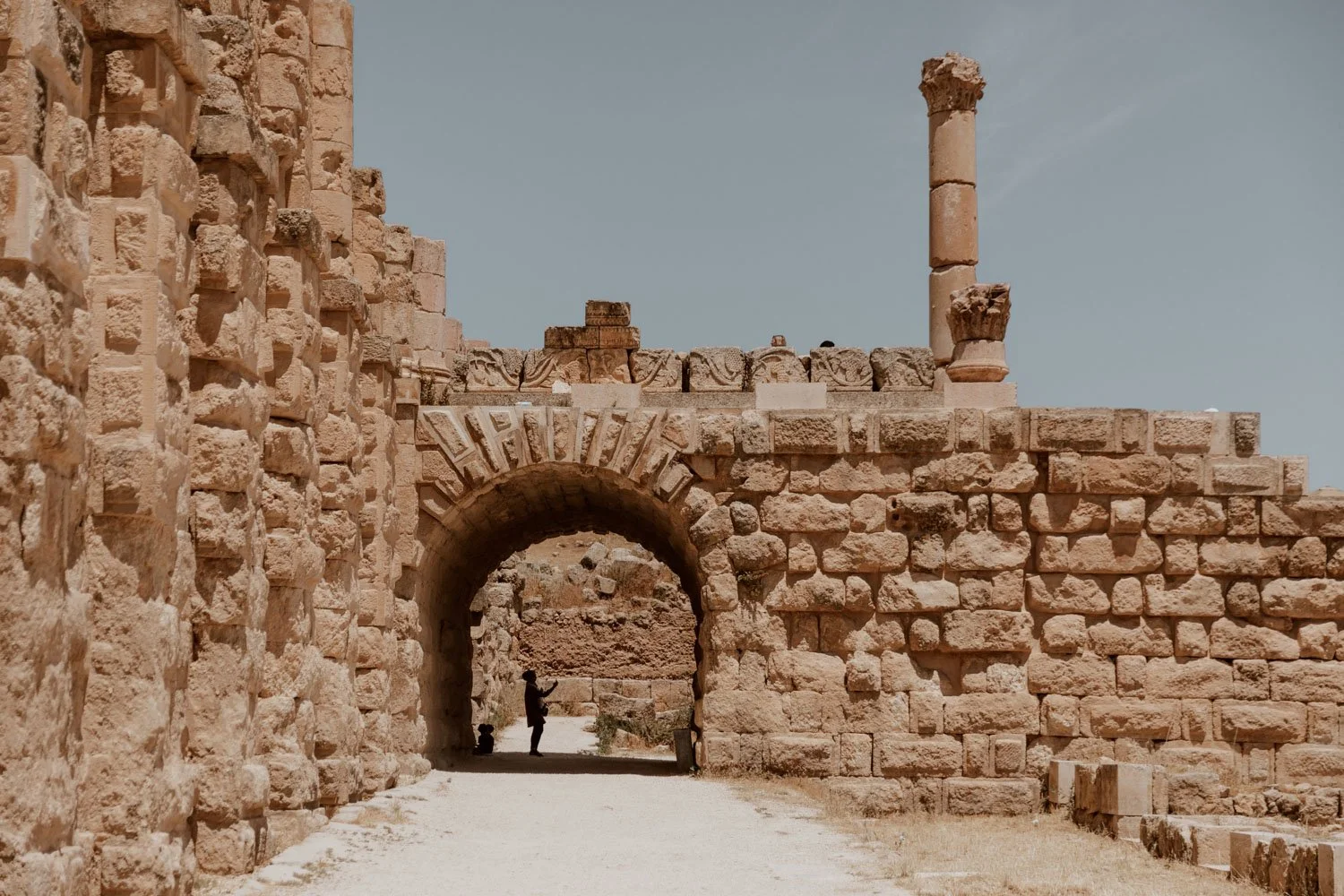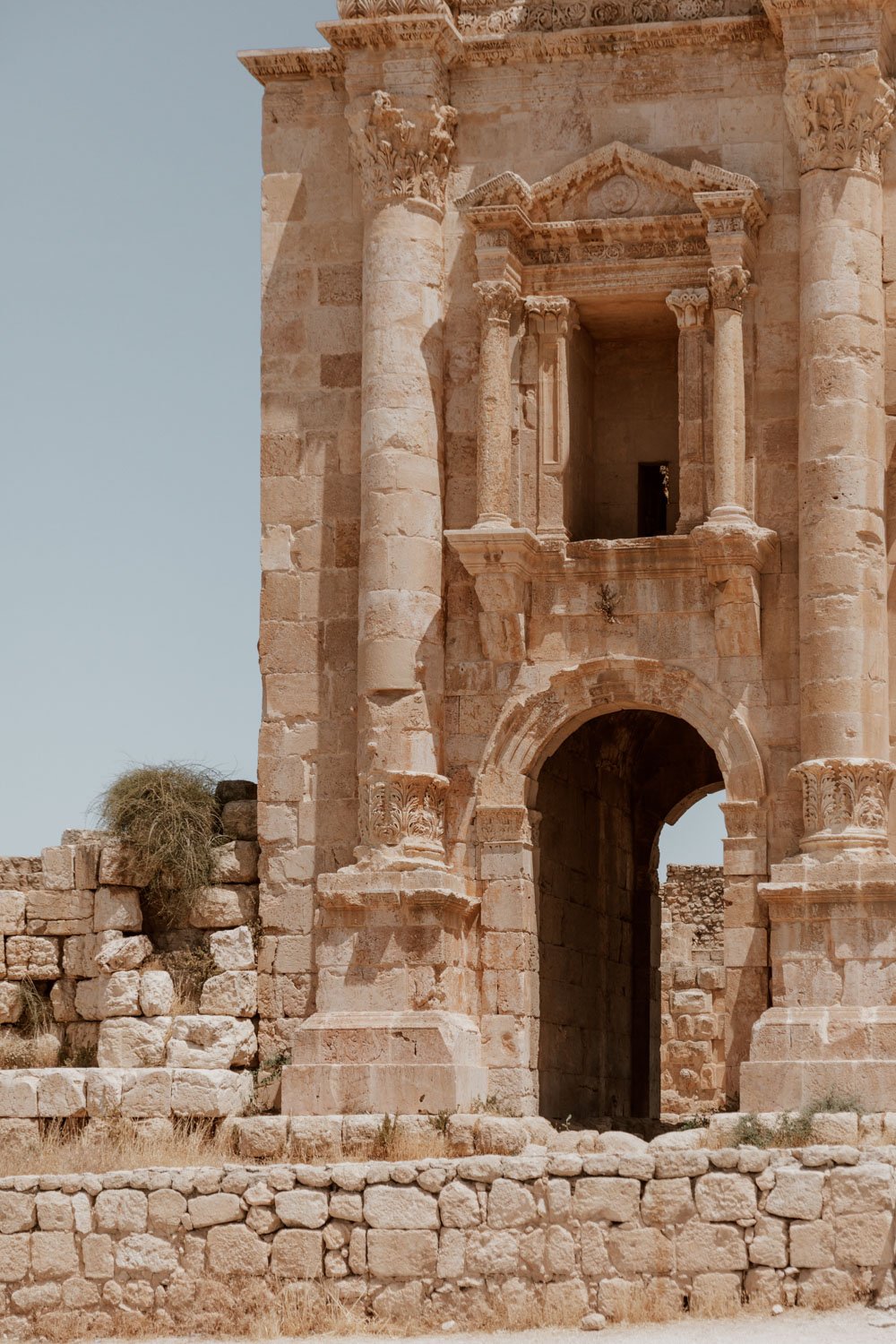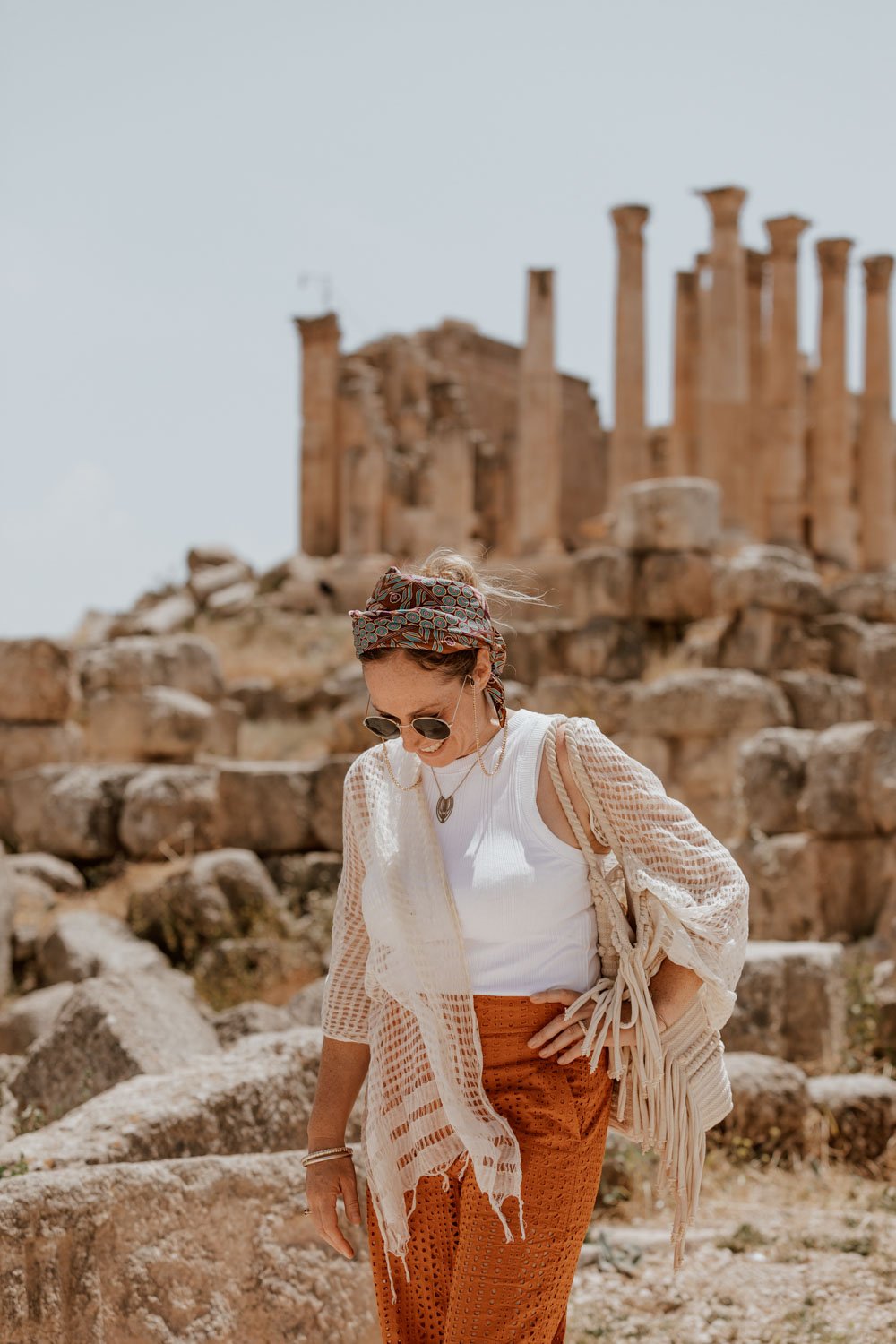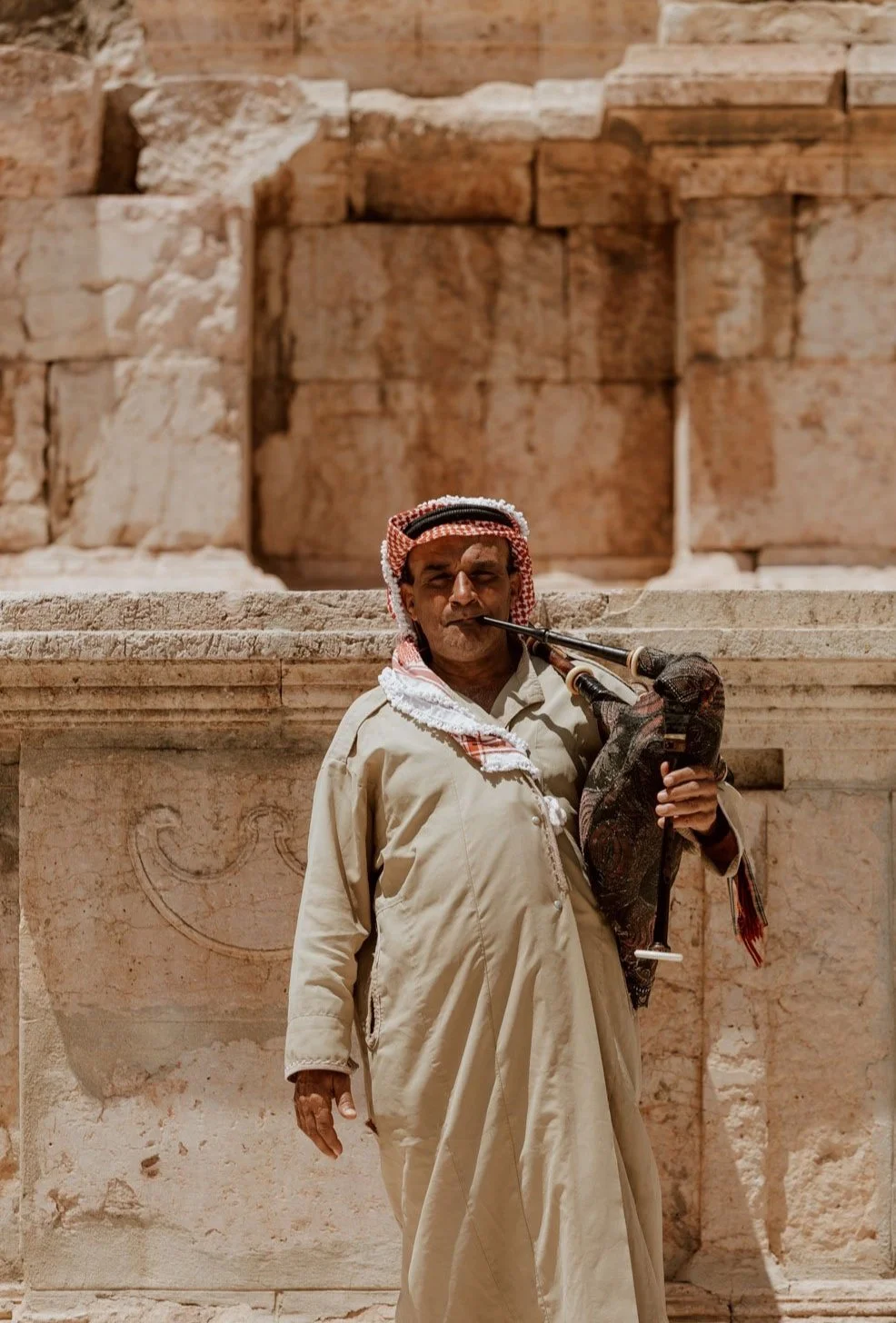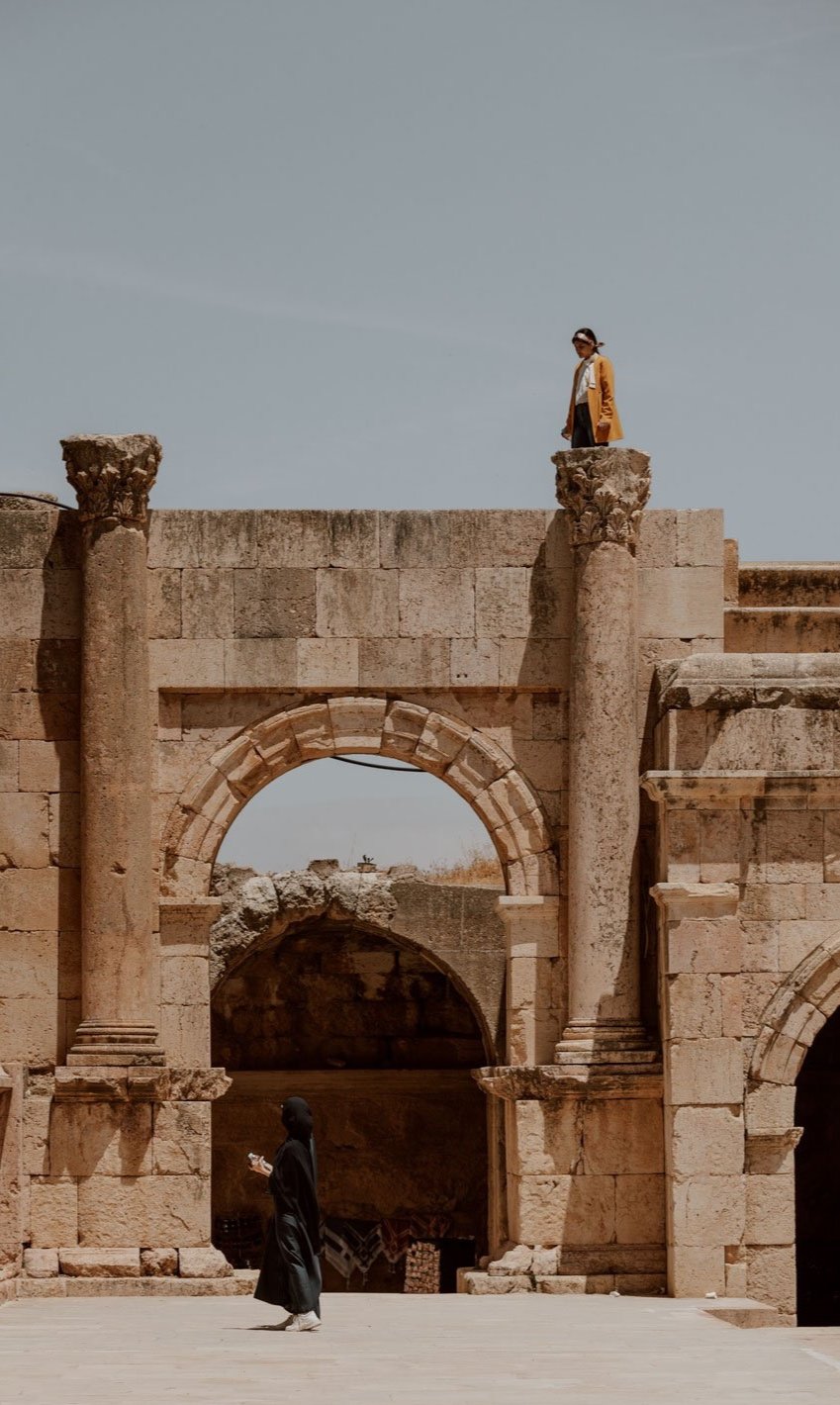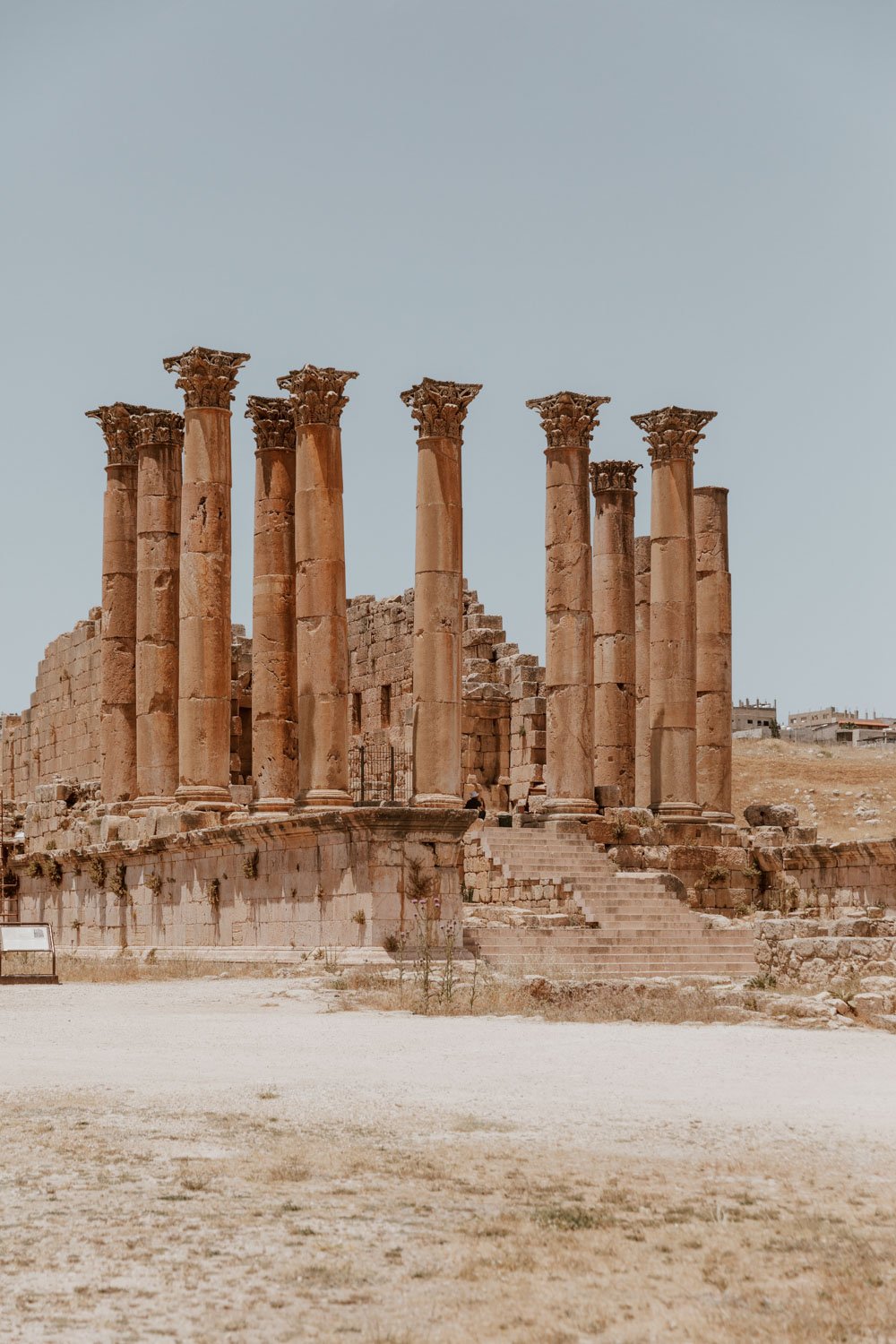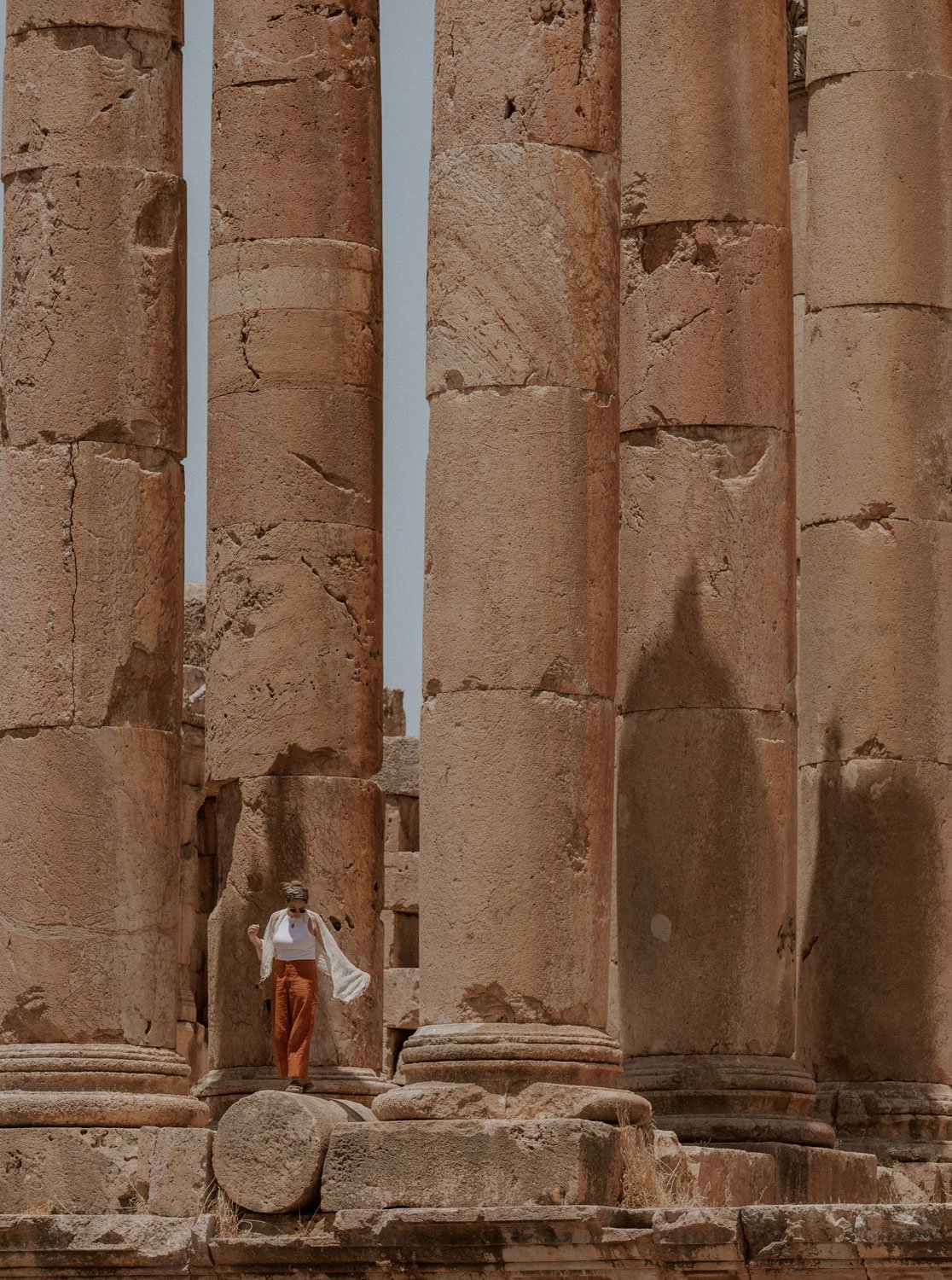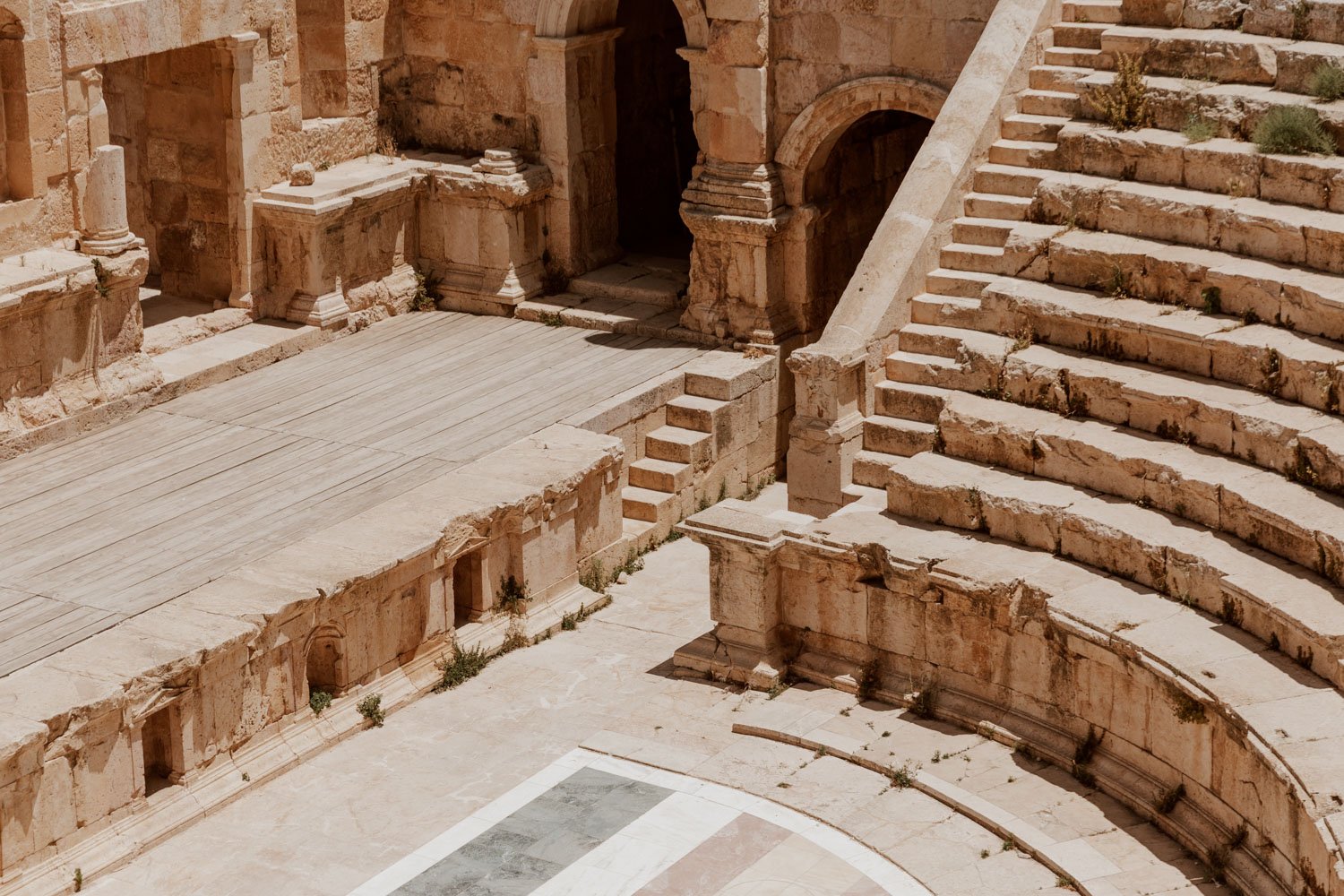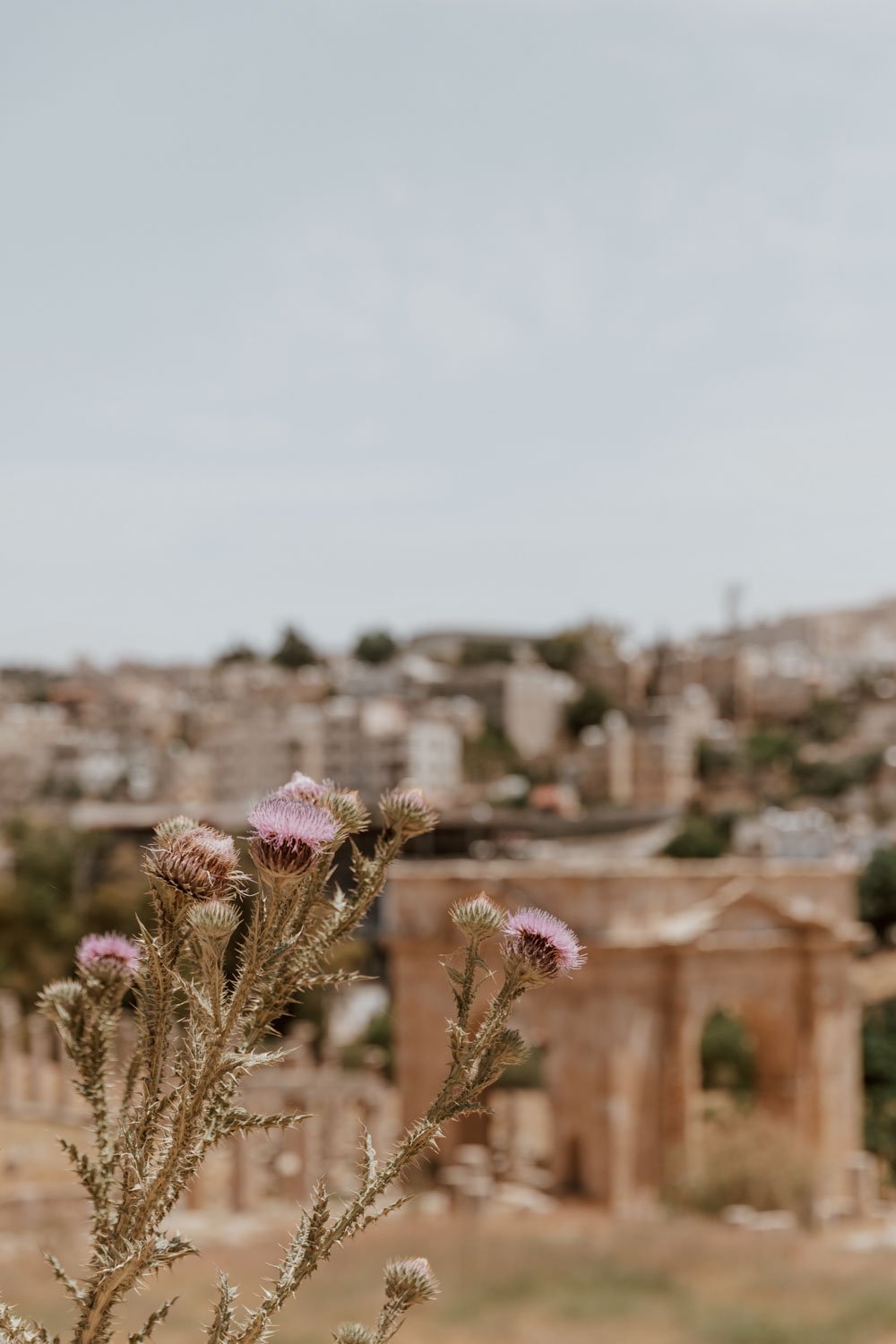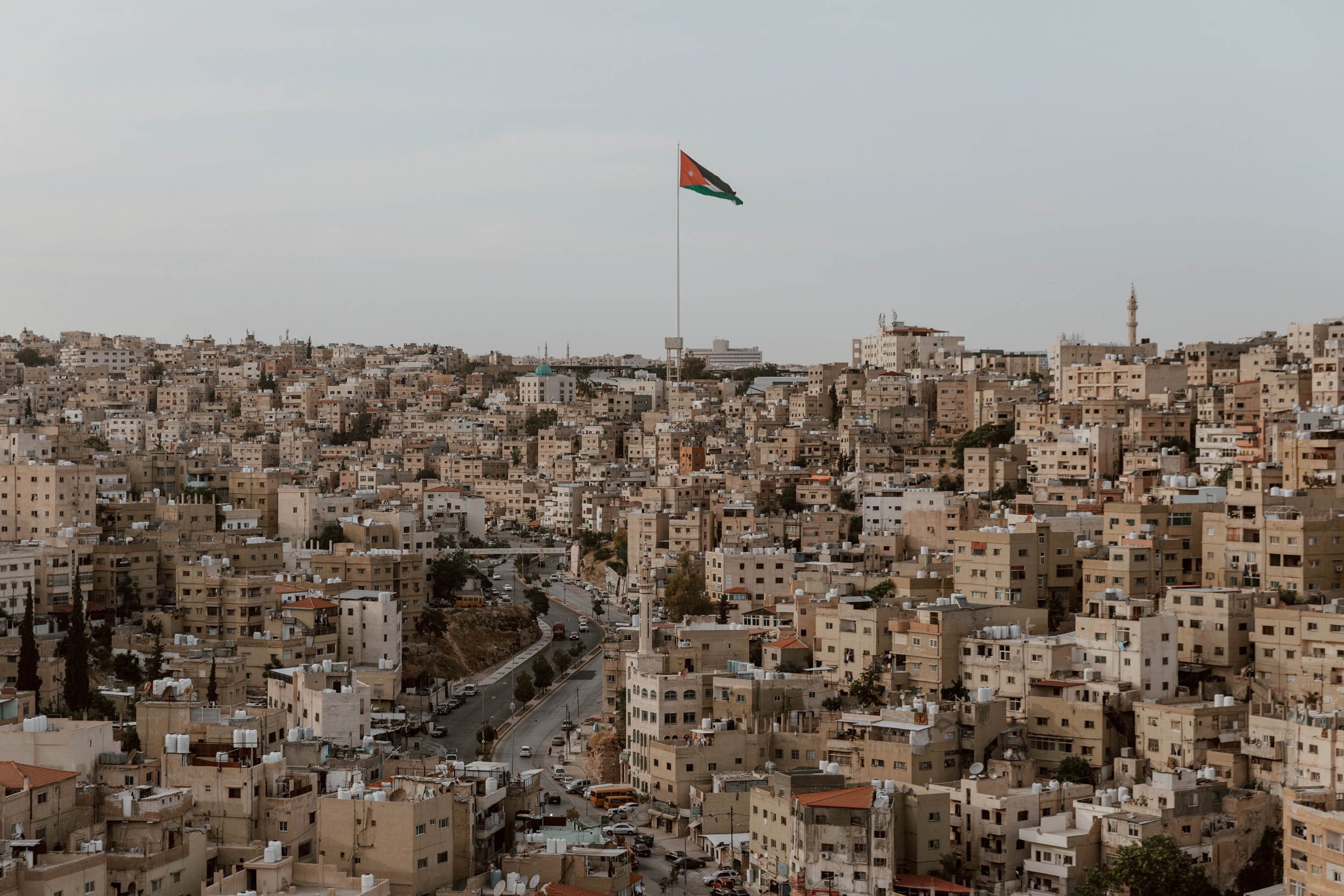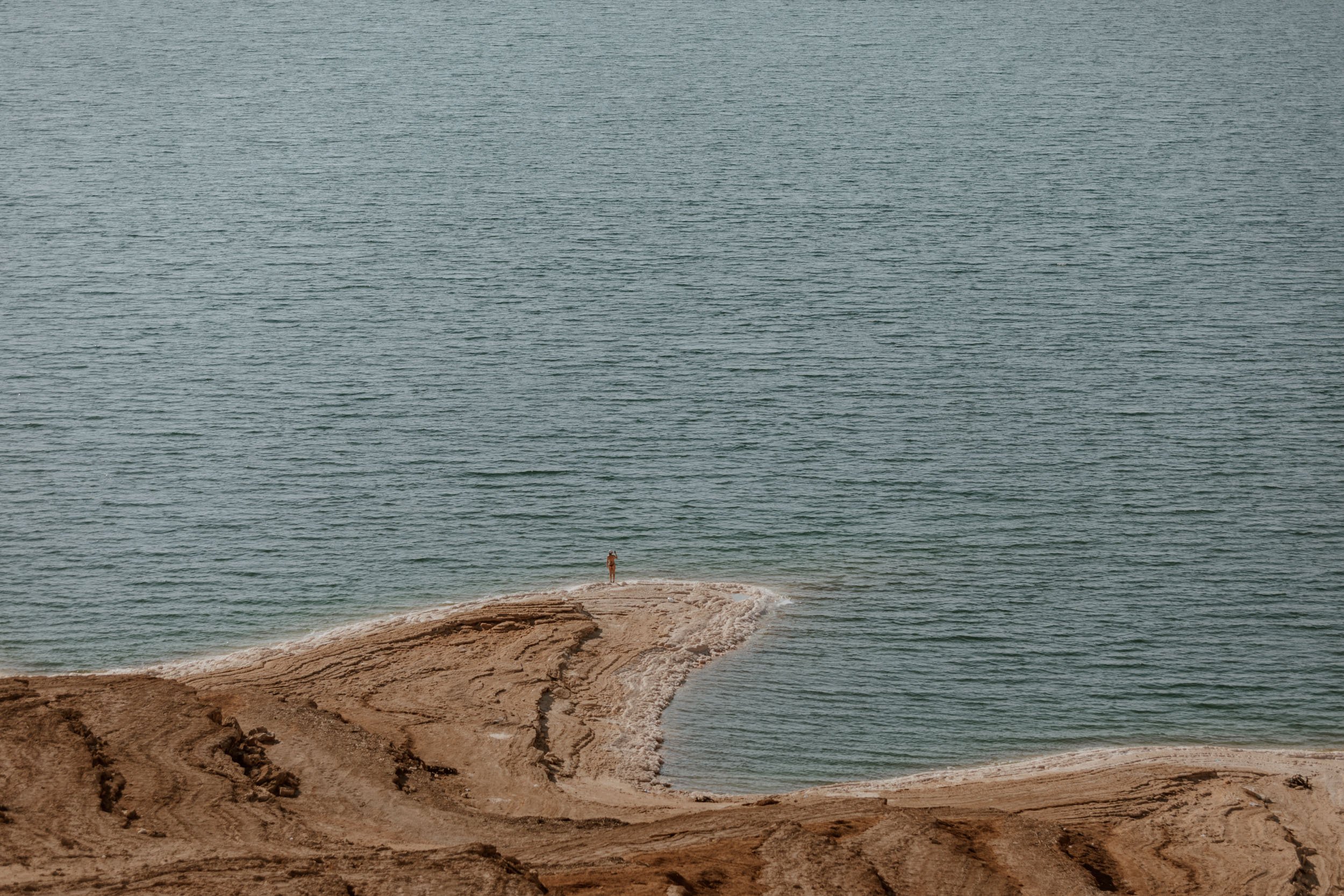Whether you visit on a day trip from Amman or as part of a longer road trip, the Jerash Ruins are an unmissable site in Jordan.
In this guide we’ll cover everything you need to know to plan your visit to the ‘Pompeii of the Middle East’ including how to get there, the best tours, what to see and practical tips.
Updated October 2023
Our first mistake was forgetting it was Friday.
In Jordan, a predominantly Muslim country, the working week ends a day earlier, meaning that on Fridays already busy touristic sites swell as locals flock to enjoy the many wonders that lie within their country.
Having succumbed to the common time-slip which occurs once one boards a plane and begins to travel, we had ceased acknowledging the days of the week some time ago.
And so, after spending the night in a charming guest house across the valley in the ‘new’ city of Jerash, we found ourselves at the gates of ‘old’ Jerash jostling for a car parking space amongst camels and candy floss men at 11am on a forgotten Friday morning (yep, leaving it to 11am was the second mistake).
Approaching the imposing Hadrian’s Arch, which marks the entry point to the ancient city, we were swept up in a crowd of young and old, generations of families shepherding their offspring and their elders through a 21-metre tall gate. A cacophony of music blaring out of mobile phones (and one incongruous boom box) rang out around us, as fast-paced Arabic enveloped our path.
The atmosphere was more local park on a sunny weekend than archaeological site, and the juxtaposition of modern-day Jordan within Ancient Rome was quite something.
However, as we made our way past the ruined structures of this great Roman city, through the Oval Forum and its still-standing columns and on to the arrow-straight Cardo Maximus - a road that stretches the length of this once booming metropolis - a curious thing happened.
The crowds dissipated, and we were suddenly quite alone; the grandeur of old Jerash - a place sometimes referred to as the ‘Pompeii of the Middle East’ - unveiled itself in the silence.
The land once called Gerasa (Jerash is the Arabised name) has been inhabited for millennia, with evidence of occupation from as early as 7500 BC. However it wasn’t until the Romans arrived in 63 BC that this ancient city atop a hill began to flourish, becoming part of the Roman province of Arabia in 106 AD (this province also included Amman and Petra).
Jerash reached its zenith in the late second and early third century, as road connections between the great cities in the east led to trade and taxation, wealth and expansion (both in population and construction); in 129 AD, Emperor Hadrian - yep, he of the UK wall fame - even sojourned here for an entire year.
Alas, as is often the case in these once great metropoli, Jerash began a slow slip into anonymity in the several centuries that followed, as trade routes that had once been so profitable were eschewed for ships that sailed the sea. Invaded by the Persians in 615 AD and conquered by Muslim forces in 636 AD, it was a devastating earthquake in 749 AD that finally consigned the city to the history books for more than 1000 years.
The Jerash that you will explore in the north of this impressive country was re-discovered by European explorers (including the infamous Burckhardt - read more about him in our Petra guide) at the beginning of the 19th century, and archeological ruins continue to be uncovered and meticulously restored even to this day.
If it weren’t for the more famous Petra and Wadi Rum in the south, we reckon Jerash in the north would attract a lot more buzz about it, with the ruins considered one of the best preserved sites of Roman architecture outside of Italy.
Whether you’re visiting Jerash on a day trip from Amman (which is very likely) or stopping by as part of a longer Jordan road trip, in this guide we’ll cover everything you need to know to plan your trip! Including how to get there, ticket info, the sites you absolutely can’t miss and our advice on where to stay if you’re spending the night.
jerash ruins essentials
What / Jordan’s best preserved Roman ruins
How / Ideal day trip from Amman, this tour combines Jerash with Ajloun Castle and is super popular
Cost / Entry included in the Jordan Pass
Time / Large site, so allow several hours
Stay / The Blue House, a charming little guest house
Plan / A day three stop on our Jordan Itinerary
How to Get to the Jerash Ruins
As we mentioned above, most people who visit the Jerash ruins can be broken down into one of two groups: those who visit as part of a day trip from Amman (the capital city), and those that include them on their Jordan road trip itinerary.
Which of these two groups you fall into will determine how you reach these impressive Roman ruins.
Rental Car + ROAD TRIPS
The easiest way to reach Jerash is with your own vehicle.
There is plenty of free parking, both in the dedicated car park (maps) and the overflow carpark around the corner (maps). Just don’t try and park in the private staff parking area (maps) on the side of the highway, which your Google Maps may direct you to if you just put in Jerash parking!
We only recommend driving here if visiting Jerash as part of a longer road trip - if based in Amman and not going on a road trip, it’s best to go with a taxi or tour rather than rent a car specifically.
Top Tip // Amman airport has a wide-range of car rental companies, several of which have offices open 24 hours. We recommend booking on either Rentalcars.com or AutoEurope, both of which aggregate and list most of the local companies as well as the main international brands. We always look + book via them for our rentals, and it often saves money over going direct.
Find more advice in 17 Things To Know Before Driving in Jordan.
Taxi
It’s possible to visit Jerash with a private taxi driver who will wait outside whilst you explore the ruins.
We had multiple taxi drivers offer us this service whilst exploring Amman, but prices depend very much upon how good you are at haggling; don’t expect to get them lower than 40JD for the return trip and remember that the art of a good haggle is for all parties to be happy.
Let us know in the comments if you have good experience or an update on prices!
Two common places in Amman where we were offered this service was outside the Amphitheatre and up at the Citadel.
Public Transport
Whilst public transport in Jordan is generally a little limited, one route that is easy to navigate without your own vehicle is that between Amman and Jerash, with frequent departures throughout the day, every day.
These leave from the Tabarbour bus terminal in the north of the city (here on Google Maps), take between 30 and 50 minutes dependent upon traffic, and cost just 1 JD per person.
Do note however that as these are local buses, they do not depart on a fixed schedule, instead leaving only when full. For this reason, if you are visiting on a day trip, aim to arrive at the terminal early.
The buses drop off only a short walking distance from the Jerash ruins. If you do this option, please feel free to share more info + tips in the comments!
Jerash Tours FROM AMMAN
The vast majority of Jerash tours - like this highly-rated and popular option - include time at Ajloun Castle (a 12th century fortress that was built under the rule of the sultan and military leader Saladin), and Umm Qais. Do note that this particular tour is a transport-only option, and does not include a guide to walk around the ruins with you. Find full details here.
If you’d prefer to focus purely on Jerash and be led through the ruins by an English-speaking guide, consider this popular option. It also includes entrance to Jerash, which is useful if you don’t plan on buying the Jordan Pass.
For those looking for a multi-day tour that includes Jerash Ruins, consider this three-day option which also visits Petra, Amman, Wadi Rum and the Dead Sea, and has lots of excellent reviews.
Jerash Tickets & Opening Times
The opening times for the Jerash ruins depends on the time of year:
8am to 4pm November to March
8am to 5.30pm April & May
8am to 6.30pm June to October
9am to 5pm during the month of Ramadan.
Entry is included within the Jordan Pass, and you will be asked if you have one upon arriving at the entrance gate. A simple ‘yes’ from us was all that was required to be allowed through this first set of gates, but we were required to formally present it upon arriving at the South Gate of the ruined city.
If you don’t buy the Jordan Pass, you can pay for your entry ticket upon arrival. This costs 12 JD per person and also includes the nearby archeological museum.
Find out more about the money-saving benefits of the Jordan Pass in this post.
What to See and Ruins Not to Miss
Okay, first things first - have you packed your walking shoes?
Whilst you definitely don’t need to strap on a pair of hiking boots to visit Jerash, in the process of exploring this ruined Roman city, you will certainly cover a fair few kilometres.
There’s a fairly obvious circular route that you can follow, which will lead to you to and past the major attractions within Jerash, but if you’re looking to cover the highlights, be sure to add the following to your map. We recommend setting aside three hours to slowly enjoy and explore!
Hadrian's Arch
Towering over all who visit, this 21-metre high, intricately decorated arch - also known as the Triumphal Arch - is the gate through which you’ll enter the ancient city. Built in 129 AD to commemorate the visit of Emperor Hadrian, it was intended to be the city gate of a new southern quarter along the road to Amman - a plan that would soon be abandoned as Jerash’s finances slipped into decline.
It’s for this reason that the arch remains a freestanding structure, nearly 500 metres from the Southern Gate and the rest of city.
You can find Hadrian’s Arch here.
The Hippodrome
As you make your way toward the South Gate, you will pass the huge hippodrome - an ancient sports field - built between the first and third centuries that was designed to accommodate up to 15,000 spectators.
Excited to explore Jerash, we actually missed it when we first entered through the arch, and whilst it wasn’t our favourite part of the city, it’s definitely worth poking your head into on the way back or at the beginning!
You can find the Hippodrome here on Google Maps.
The Oval Forum
After passing through the South Gate, you will reach one of Jerash’s most celebrated sites - the Oval Forum (or Oval Plaza).
Highly regarded for its form (it’s the only oval-shaped plaza in a Classical-era city), it also remains remarkably well-preserved, with the many original eight-metre columns having been re-erected, not simply replaced, and the paving stones the very same that were laid by the Romans.
You can find the Oval Forum here on Google Maps.
Tip // If you look left and behind the Oval Forum, you will see what looks like a pile of rubble, however these are actually the remains of the sanctuary of Zeus (162-166 AD). The ruins themselves are not particularly interesting but they make a wonderful vantage point from which to view the Oval Plaza below.
The South Theatre
The South Theatre is considered by many to be one of Jerash’s most impressive structures, not least because of the astonishingly large amount of work that has gone into restoring it.
Built around 90AD, this huge two-storey structure could seat more than 3,000 spectators, and was constructed with an eye on enhanced acoustics, thereby allowing a single speaker in the centre of the orchestra floor to be heard - without shouting - throughout the entire theatre.
You can find the South Theatre here on Google Maps.
Did You Know? // Upon entering the South Theatre, you may well encounter a bagpiper or two roaming the internal walls. Whilst this may seem a little out of place (actually, scratch that - we found it down right bizarre), there’s a good reason. Not only does it provide an excellent demonstration of the theatre’s incredible acoustics, it’s also an example of Jordan’s bagpiper tradition that dates from the period of British colonial rule when, during the process of setting up and training the army, bagpipe bands were also created. Despite the British Mandate ending decades ago, the instrument has remained popular with Jordanian musicians even performing at the Edinburgh Tattoo!
They don’t play to a particular schedule, but tend to enter the theatre during busier times of the day. The bagpipers are happy to pose for a photo, but ask for a donation - 1 JD seemed about right.
Cardo Maximus
Also known as the ‘Colonnaded Street of Jerash’, this wide paved street runs 800 metres from the Oval Forum to the North Gate; an arrow straight Roman road, lined by millennia-old columns, and still paved with original stones, its draws a line straight through the heart of the ancient city.
Cardo Maximus begins here - the further you walk toward the end, the fewer people you’ll be sharing it with!
The Cathedral Complex
Whilst the Romans were originally a polytheistic civilisation, by the mid-4th century (the beginning of the Byzantine period) the city of Jerash had a significant Christian population, the growth of which culminated in the building of the ‘Cathedral’.
Built in the first half of the 5th century, atop the Roman Temple of Dionysus (the ornately carved gateway through which you enter the complex itself), this was the first church built in Jerash.
You can find the Cathedral here on Google Maps.
Other nearby churches to stop by include: The Church of St. George (maps), The Church of St. John the Baptist (maps), and The Church of SS Cosmas & Damian (maps), all built between AD 529 and 533.
Did you know? // There is no actual evidence that this church was considered to be a Cathedral (that is, the seat of the Bishop), and modern historians are yet to know exactly where this name came from.
Nymphaeum
Once you’ve explored the Cathedral Complex, you’ll continue along the Cardo Maximus to reach the Nymphaeum - a large public fountain, and the best preserved in any Classical-era site in Jordan.
Built towards the end of the 2nd century, this elaborate construction was much more beautiful than it perhaps had to be, built with marble, sculpted Corinthian columns, and seven carved lions’ heads from which the water would cascade into a large pink granite basin below.
You can find the Nymphaeum here on Google Maps.
Top Tip // There was a chap with a stall in front of the fountain who, after showing his wares was keen to give us an example of how the Romans constructed their buildings to resist earthquakes. Using a simple metal teaspoon which he inserted between two perfectly carved stones, we could see the natural sway of the columns. Keep an eye out for him!
Sanctuary of Artemis
Built in the mid to late 2nd century and dedicated to Artemis, the goddess of hunting and fertility (and the daughter of Zeus and Leo), this temple is believed to have been Jerash's largest and most important.
Visitors are able to enter through the propylaea, a monumental gateway that was reconstructed in the late 1920s by the Jordanian Department of Antiquities, and climb the stone staircase to enter the inner temple, the altar terrace and finally, the temple platform.
Remarkably, eleven of the twelve huge Corinthian columns that rim the temple platform remain standing, and are the most impressive feature of the building.
You can find the Sanctuary of Artemis here on Google Maps.
Top Tip // If you’ve still got the energy, keep going until you reach the North Gate (maps) for incredible views over the modern city of Jerash across the valley.
The North Theatre
The North Theatre may be significantly smaller than its southern counterpart, but we actually think it’s our favourite.
Seating just 1,500 people even after its third century extension, the impressive semi-circular structure was likely used for council meetings rather than public performances (a fact supported by names of council delegates inscribed upon the stone seats), before its destruction during the 749 AD earthquake.
Having undergone painstaking reconstruction in the 1990s, the theatre has been restored to an exceptionally high standard; archeologists are confident that the building that stands today is a true reflection of the Roman creation.
Be sure to head up to the top tier of seating for fantastic views over Jerash, and even ‘tread the boards’ yourself to step back in time on the stage.
You can find the North Theatre here on Google Maps.
Did You Know? // The world’s oldest known machine - a water-powered stone cutter dating from 550 AD - was discovered in Jerash. The original is now safely tucked away in a museum, but you can find a perfect replica here, near the Cathedral.
Best Time to Visit Jerash
Jerash experiences much cooler weather than elsewhere in Jordan, with temperatures in January dropping to as little as 5°C. Additionally, between the peak tourism months of November to March, grey skies and a fair amount of rain are par for the course.
So, Jerash may be a little bleak and require plenty of layers when the rest of Jordan is pleasantly warm in the day.
This means that, technically, the best time to visit Jerash is in Jordan’s summer months, but to do so would mean exploring places like Wadi Rum and Petra when the temperatures are unpleasantly, dangerously high - definitely something we’d advise against.
When we visited in May, the weather was perfect, with clear skies and around 25C.
Tips For Visiting the Jerash Ruins
· After the main entrance, you will pass through a small undercover market selling everything from the usual Jordanian themed tourist merch to some pretty decent art. Expect stall holders to vie for your attention, but we didn’t experience any aggressive hard-selling.
· It’s in this area that you’ll also find the main toilets, but note that there is an additional set within the site, near the South Theatre - find them here.
· For those visiting on a Friday (like we did), aim to arrive as early as possible as it gets extremely crowded and parking becomes very limited by late morning.
· If visiting during the warmer months, be sure to carry plenty of water with you. There is a small outside cafeteria just after the market area to stock up if you forgot your own, and it also makes a pleasant place to grab some shade and a snack after your explorations.
· There’s a small museum on-site with a number of interesting artefacts on display. Worth popping in, if only for a break from the sun!
· As this is a pre-eminent archaeological site, it is imperative that no stones or any other artefacts found within Jerash are taken as souvenirs.
· There are limited places to deposit rubbish within Jerash, so be mindful of your litter and keep it with you until you can get rid of it properly.
· As we discussed earlier, Jerash is a large archeological site and whilst you don’t need specialist walking shoes it is imperative that you wear something you can walk comfortably in for several hours. We both wore our trusty Birkenstocks and had no issues!
· The same goes for clothing - wear an outfit that is appropriate for the weather. In the winter, this will mean a rain jacket and perhaps an umbrella, and in the warmer months a hat and clothes that protect you from the sun (women should be relatively covered anyway, given the cultural norms of Jordan).
· How long you decide to spend in Jerash depends very much upon how much interest you have in archeological ruins. If you are on a tour you likely won’t have too much say in your arrival and departure time, but for those visiting independently we’d recommend factoring in three to four hours to properly explore Jerash’s highlights.
Where to Stay in Jerash
Whilst many people choose to visit the Jerash Ruins on a day trip from Amman, as we were visiting the city as part of our longer Jordan road trip, we actually opted instead to spend the night in the city.
As is common in various cities across Jordan, there’s not a huge amount of choice in Jerash, with the following being our pick:
Guest Houses & Hostels
The Blue House | This charming guest house is where we stayed - and where we’d recommend in a heartbeat for those who don’t require luxury or anything too fancy. Run by a welcoming family, it’s super cosy with large comfortable rooms and a good-sized terrace with great views over Jerash. The breakfast was also truly excellent! Parking available on a nearby street. Check availability and prices on Booking.com or Airbnb.
Full Panorama to Jerash | With nearly 1,400 positive reviews, this well-located accommodation is another safe bet. They offer a variety of different rooms - some with kitchens - which are clean and modern, free breakfast and can provide cooked dinners for a fee. Do note that despite its name, the terrace only has a limited view of the ruins. Find out more here.
Ruins Wall Hotel&Hostel | The only place in Jerash offering dorm beds, this well-rated accommodation also offer a variety of private rooms (clean and comfortable, if a little basic). Facilities include a shared kitchen and a communal living area. Find out more here.
There are a number of Airbnbs in Jerash, but many are either a drive away from the archeological park, or not necessarily somewhere we’d like to stay, so we don’t have any specific recommendations. You can see the full list of Airbnbs in Jerash here.
Where to Next?
11 Wonderful Things to Do in Amman
16 Really Useful Things to Know Before You Visit Amman
Where to Stay in Amman (published soon)
Our Definitive Guide To Visiting Petra
Driving in Jordan | An Essential Guide
A Complete Guide to Visiting Madaba | Jordan’s Mosaic City
13 Wonderful Things to Do in Jordan



